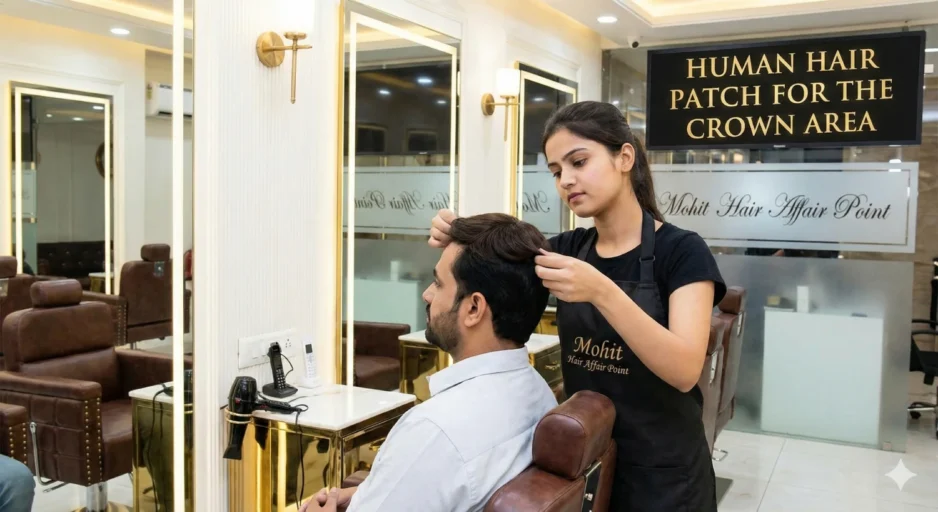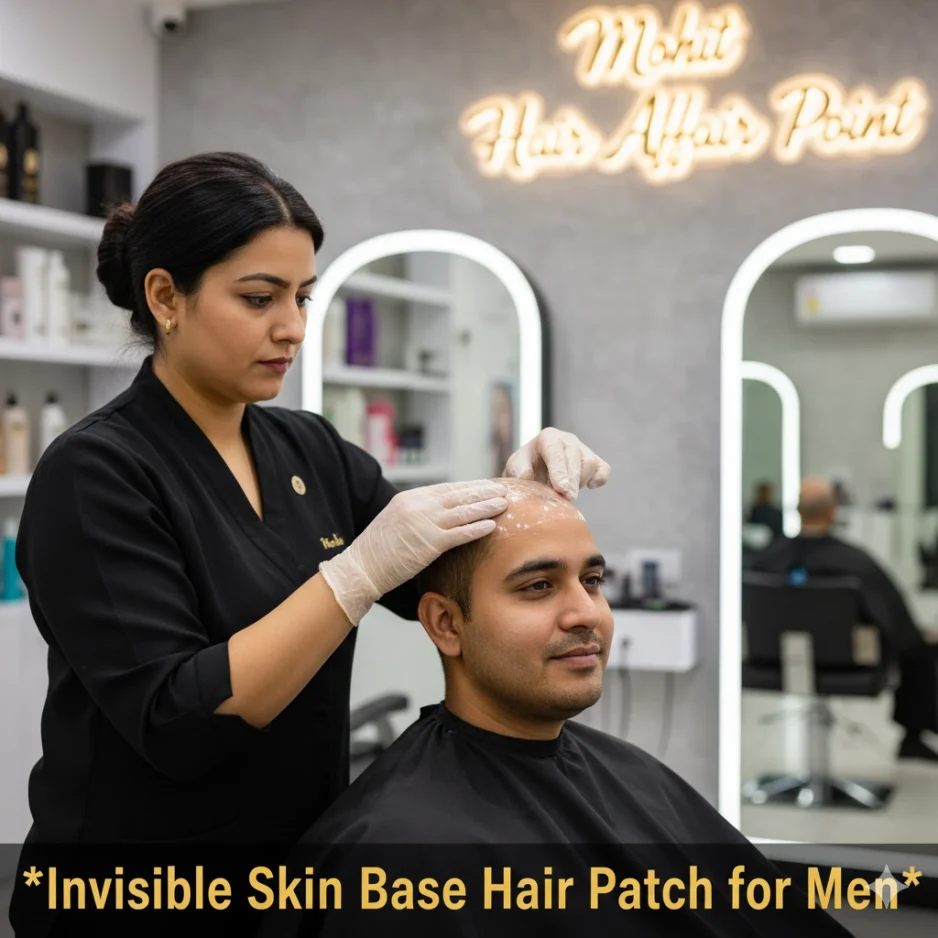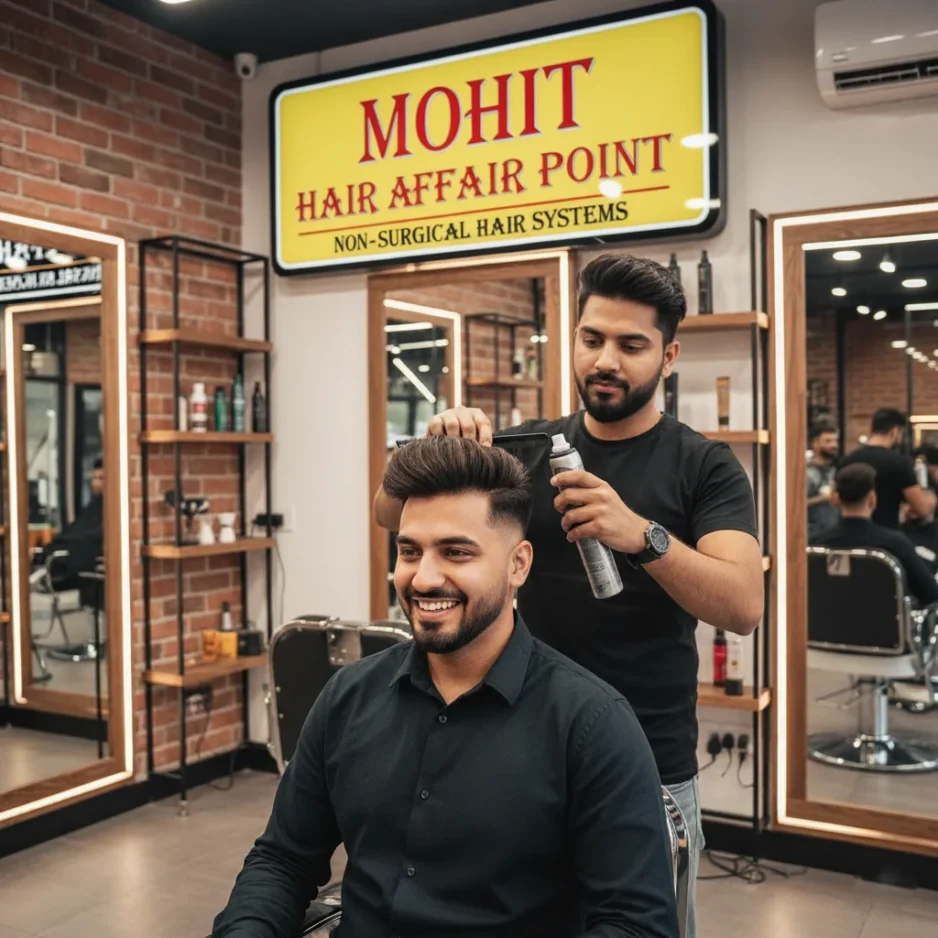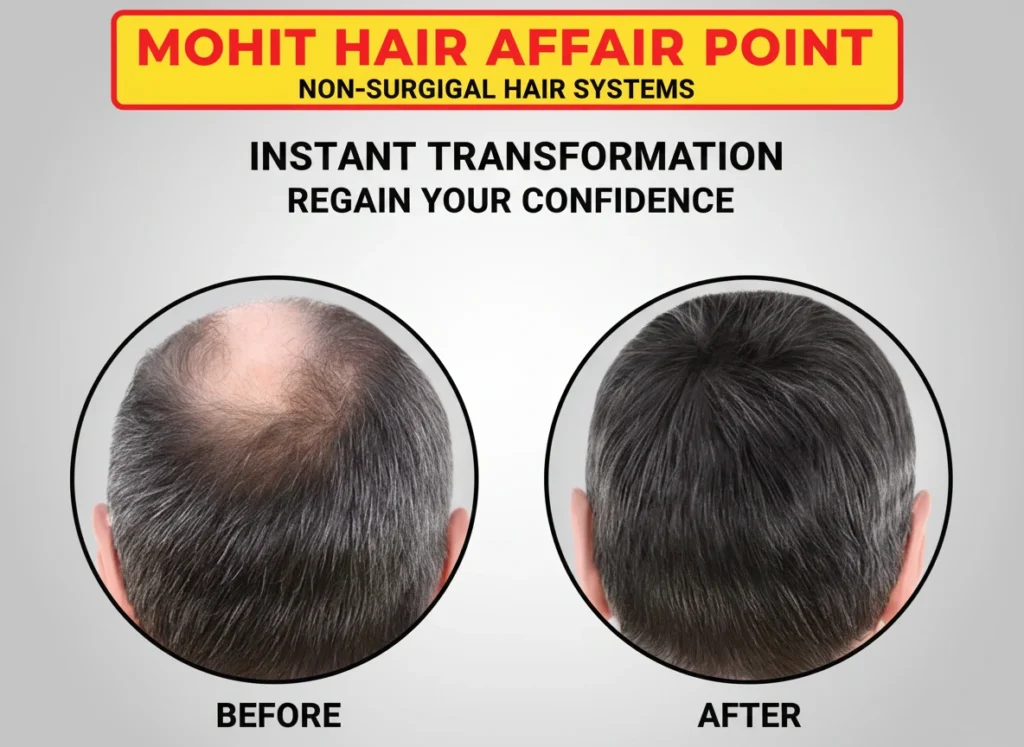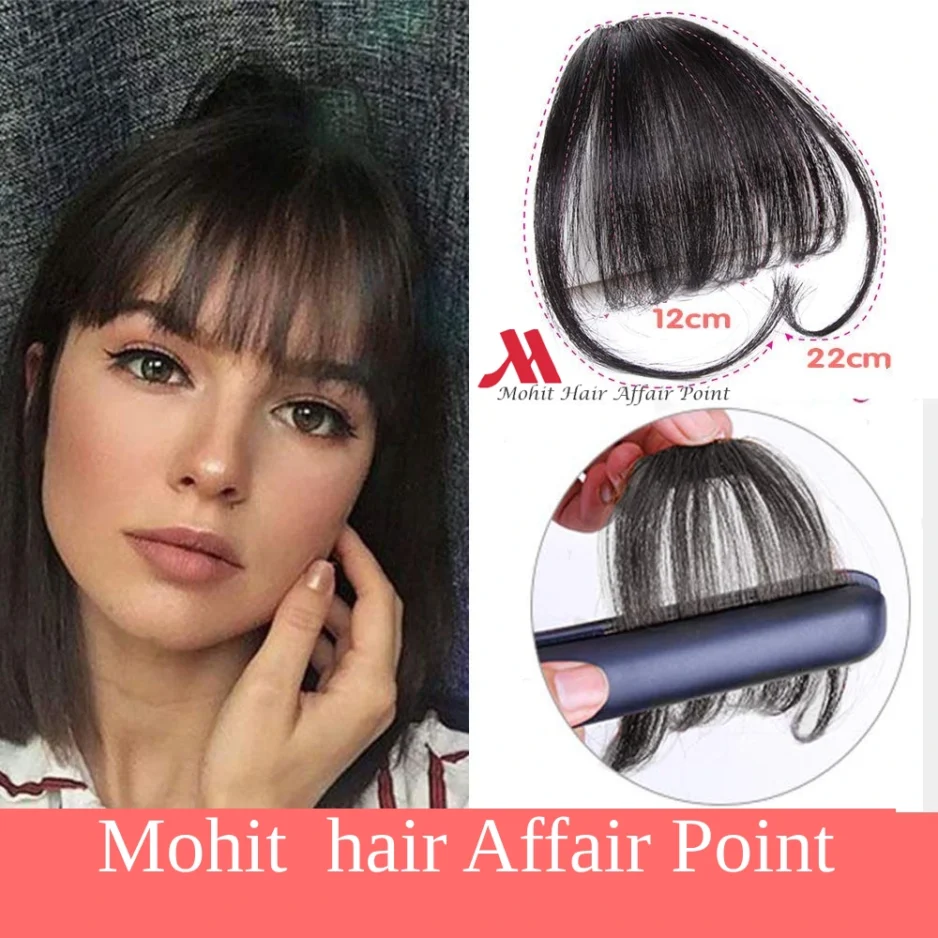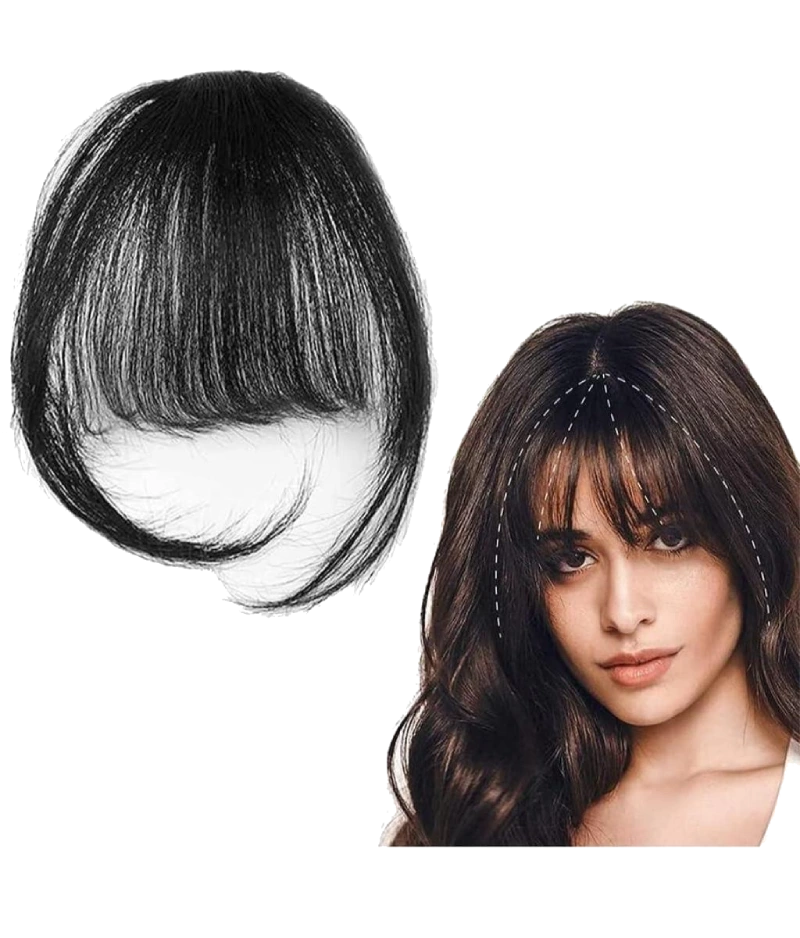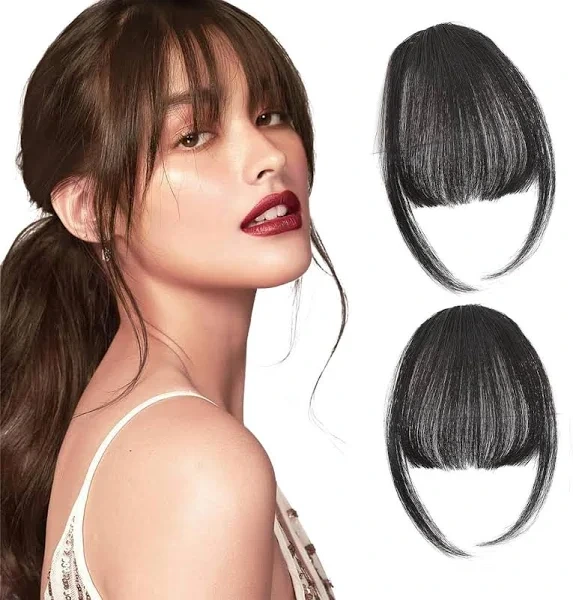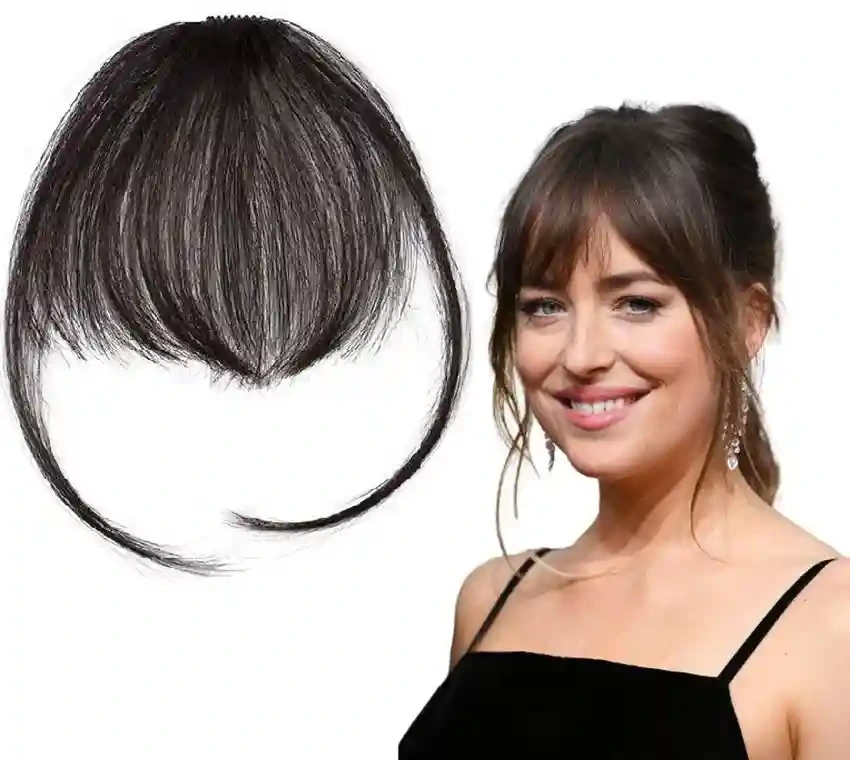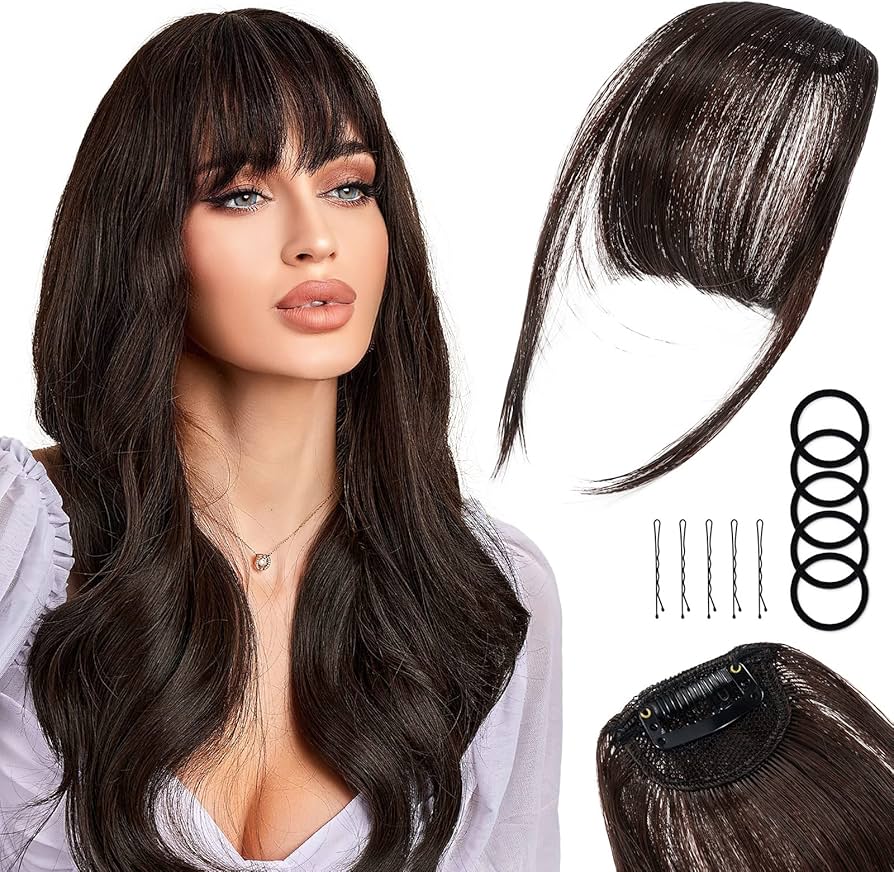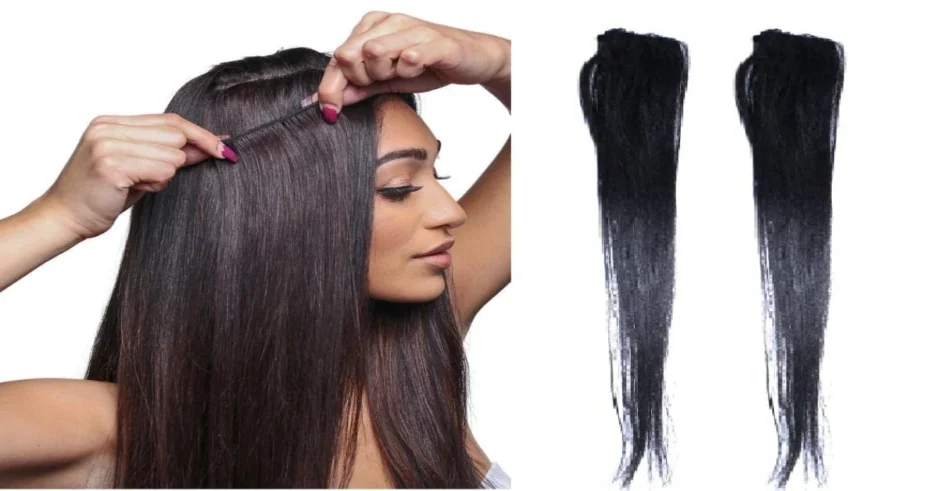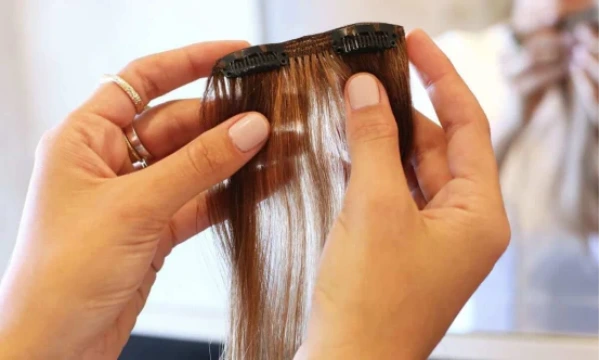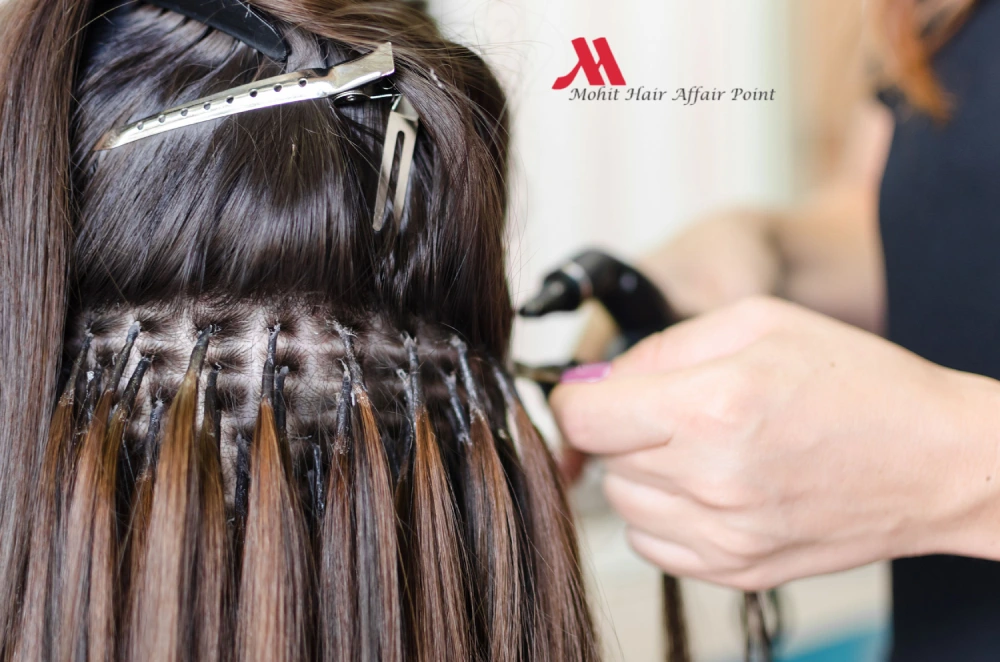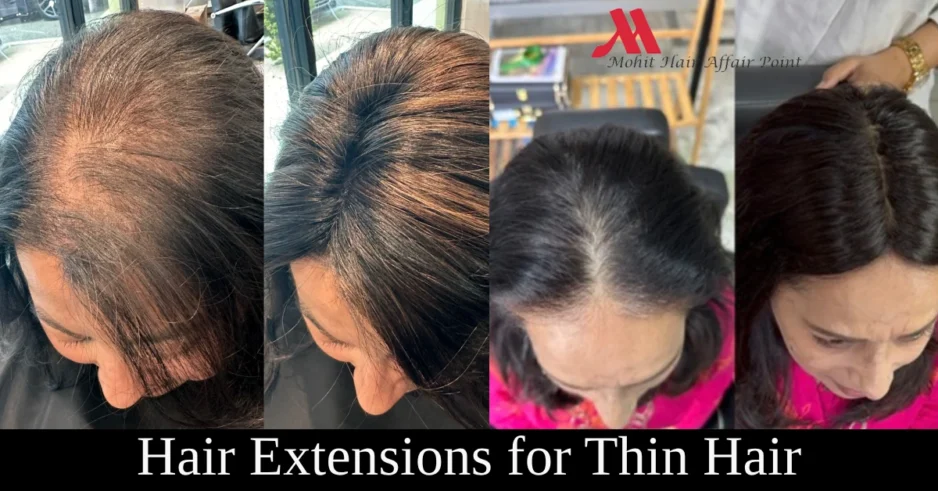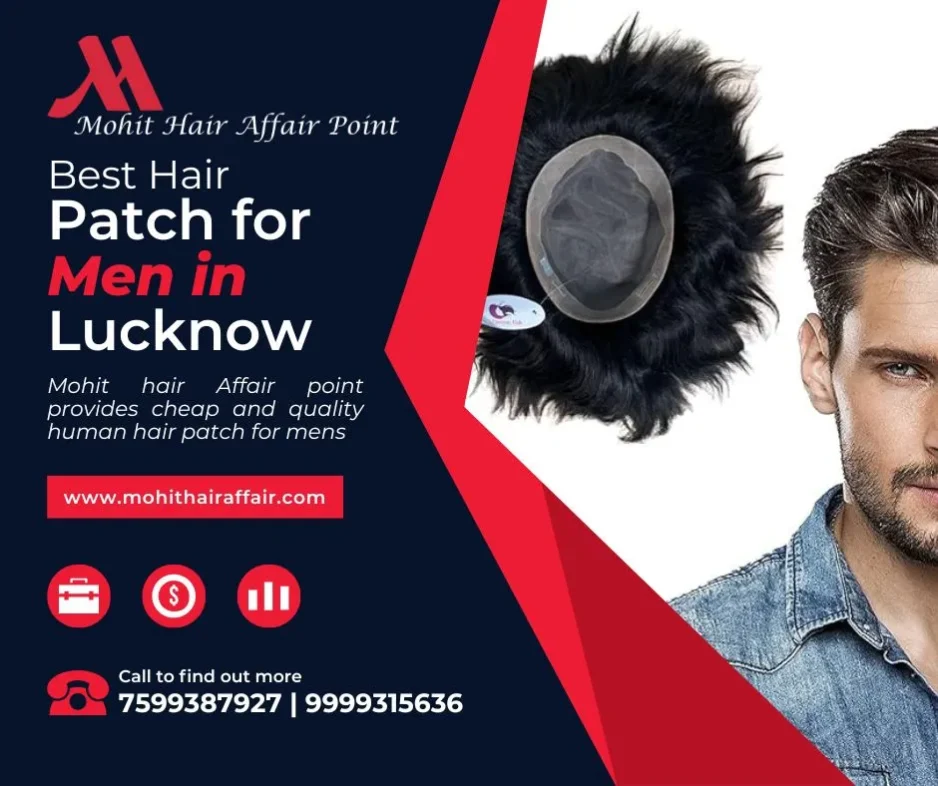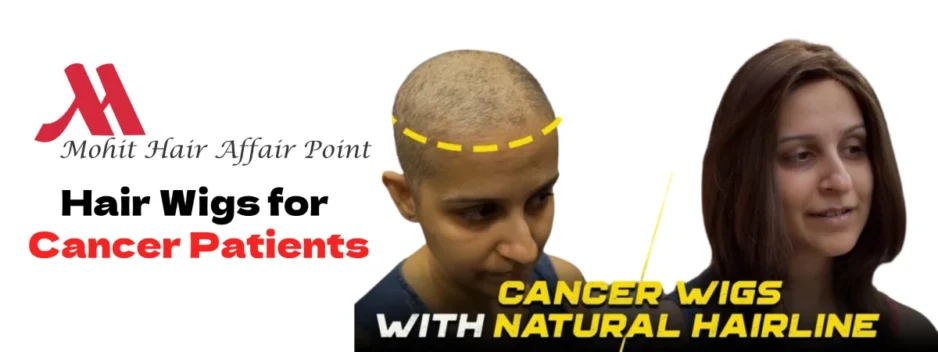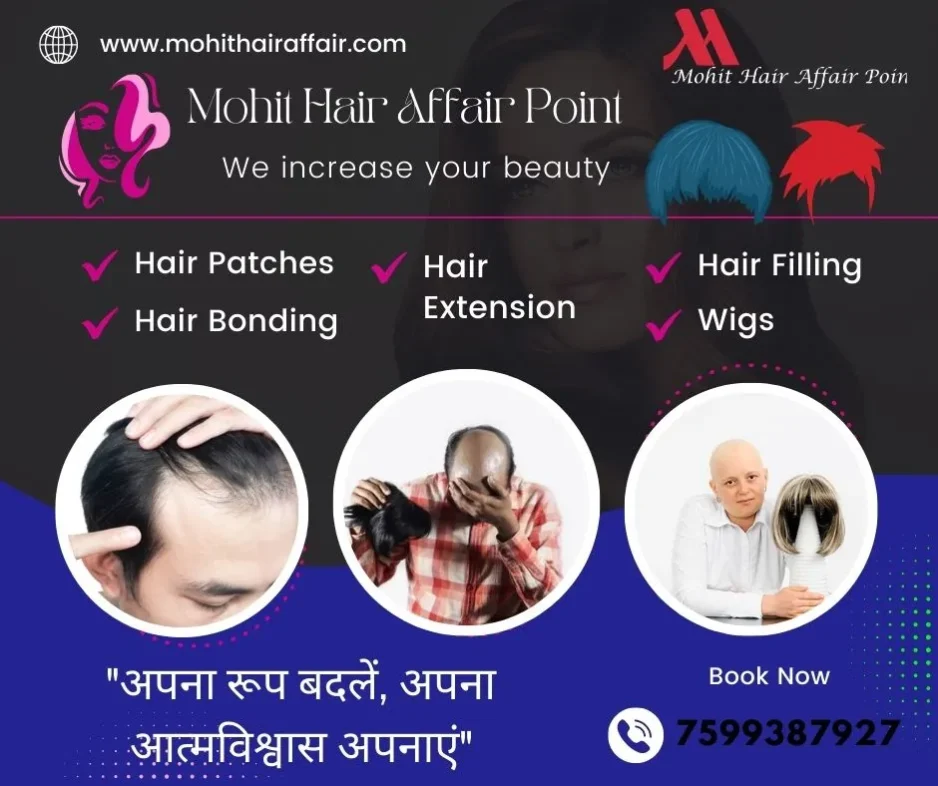Introduction: Reclaiming Your Confidence, Affordably
Many believe that the only effective solution is costly hair transplant surgery, placing quality hair restoration out of reach. At Mohit Hair Affair Point, we challenge this notion. We understand that your hair is central to your identity, and we are dedicated to providing an Affordable human hair patch for the crown area that offers a completely natural appearance without requiring a significant financial outlay.
This in-depth guide is designed to demystify the pricing structure of hair patches and show you exactly how to secure the highest quality Natural Human Hair replacement systems right here in Lucknow.
Table of Contents
Addressing Crown Area Baldness: Why Non-Surgical Solutions Lead
1.1 The Challenge of Crown Baldness
Male Pattern Baldness often makes its earliest and most visible appearance on the crown, or the top-most back section of the head. This area’s high visibility, especially when sitting or bending down, makes hair loss here particularly distressing, often accelerating the perception of aging and diminishing self-esteem.
1.2 Why Choose a Hair Patch Over Other Methods?
While pharmaceutical options, topical treatments, and surgery exist, the non-surgical hair patch (or hair system) has become the most practical and sought-after solution, primarily due to its:
- Instant Results: Achieve a full head of hair and your desired style in less than two hours, a stark contrast to the months required for surgical results.
- Zero Downtime: The procedure involves no incisions, stitches, or painful recovery period.
- Superior Cost-Effectiveness: Hair patches are significantly less expensive than hair transplantation, making them the superior affordable human hair patch for the crown area option.
Quality Unveiled: Synthetic Fibers vs. Natural Human Hair
Choosing the right hair type is the single biggest determinant of both price and the final, natural look.
2.1 The Critical Difference: Synthetic vs. Natural
| Feature | Synthetic Hair Patch | Natural Human Hair Patch |
| Appearance | Often appears unnaturally shiny; looks and feels coarse. | 100% realistic; flawlessly mimics the texture and movement of your own hair. |
| Styling | Cannot be heat-styled; prone to melting/damage from high temperatures. | Can be washed, colored, straightened, and styled just like your biological hair. |
| Durability | Shorter lifespan; tends to matte and tangle quickly. | Highly durable; lasts much longer with appropriate care. |
At Mohit Hair Affair Point, we exclusively recommend high-grade Natural Human Hair patches to ensure a seamless blend. For those seeking a quality Crown Hair Patch in Lucknow, natural hair is the only choice for an undetectable result.
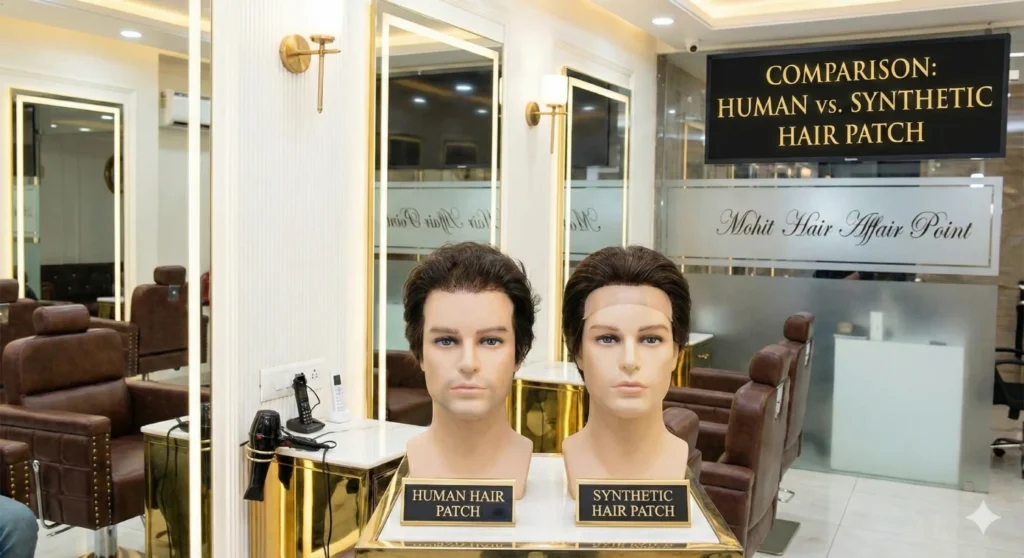
2.2 Understanding Hair Grades: Remy Hair
Remy Hair is considered the premium standard in hair replacement. This denotes hair in which the cuticles (the outer layer of the hair strand) are all aligned and face the same direction. This crucial alignment prevents tangling, preserves natural luster, and significantly extends the life of the patch. While Remy hair systems are priced higher, their superior look and longevity offer the best long-term value.
Demystifying Hair Patch Pricing Factors
Why does the cost of hair patches fluctuate so widely? The price is primarily driven by three critical components:
A. The Base Material (The Foundation of the System)
The base is the material the hair is attached to and is responsible for comfort, breathability, and realism.
- Monofilament (Mono) Base: A sturdy, durable mesh material offering excellent ventilation. It’s highly reliable and provides great strength, making it an excellent budget-friendly choice.
- Lace Base: Features an extremely fine, transparent mesh that is almost invisible against the skin. It is lightweight, highly breathable, and provides the most natural-looking front hairline.
- Silk Base: The hair is threaded through layers of silk material, completely concealing the knots. This creates the illusion that the hair is growing directly out of the scalp, offering the highest level of realism. It is often the most premium option.
- Skin/Mirage/Thin PU Base: Uses a super-thin polyurethane material (like a second layer of skin). It is exceptionally realistic when bonded but requires delicate handling.
B. Hair Quality and Processing
- Processed Hair: Hair that has undergone chemical treatment to achieve uniform colour and texture. This is generally the most budget-friendly option.
- Virgin/Unprocessed Hair: Hair that retains its natural structure, colour, and texture, providing unmatched durability and realism.
C. Specifications: Size, Density, and Length
The size of the patch (determined by the area of baldness), the desired hair length, and the required density (how thick the hair is) all influence the amount of high-quality hair used, thus impacting the final cost.
Why Mohit Hair Affair Point Offers Superior Value in Lucknow
Our commitment is to deliver the promise of an Affordable human hair patch for the crown area without compromising on quality. Here is how we ensure maximum value for our clients:
- Direct Sourcing Advantage: By eliminating layers of distributors and sourcing systems directly from trusted international manufacturers, we significantly reduce overhead costs. These savings are directly passed on to you.
- Customized Recommendations: We do not push the most expensive options. During your consultation, we meticulously analyze your lifestyle, specific bald area size, and budget to recommend the system that provides the Best Value for Money.
- Complete Price Transparency: Our consultation process guarantees full disclosure of all costs—the patch price, installation charges, and future maintenance fees. At our Vikas Nagar center, there are absolutely no hidden costs.
If you are specifically searching for the best Crown Hair Patch in Lucknow, our blend of expertise and competitive pricing makes us the premier choice.
Hair System Attachment Methods: Choosing Your Fix
The method of securing the patch impacts both cost and convenience. We offer three primary, skin-safe methods:
- Simple Safe Glue Bonding: Ideal for highly active individuals who swim or exercise frequently. The patch is secured using medical-grade adhesive, providing a secure hold for 3-4 weeks.
- Double-Sided Tape Bonding: Uses specialized, skin-friendly adhesive tape. This method is excellent for sensitive skin and facilitates easier routine maintenance.
- The Clip System: The best solution for individuals who prefer to remove the system themselves for sleeping or showering. This method is incredibly popular for crown area patches, offers flexibility, and eliminates the need for monthly professional servicing, making it extremely affordable long-term.
Mohit Hair Affair Point: The Lucknow Difference
While many clinics offer hair patches, our unique focus on client experience and technical perfection sets us apart:
- Expert Stylists & Blending: Our specialists are not just technicians; they are artists. They meticulously cut and blend the patch to your existing hair, ensuring the system integrates perfectly in terms of volume, flow, and direction—making it truly undetectable.
- Client Privacy and Comfort: We operate with the highest level of discretion, ensuring a private and comfortable consultation and fixing environment.
- Comprehensive After-Care Training: Our relationship continues after installation. We provide detailed, hands-on training on proper cleaning, maintenance, and styling to maximize the lifespan of your Natural Human Hair investment.
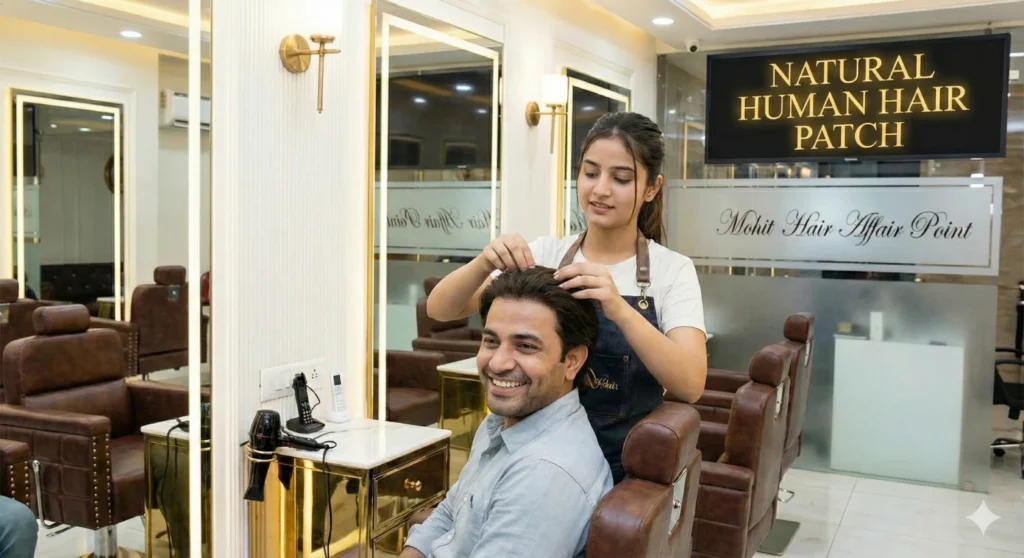
Hair Patch Maintenance: Protecting Your Investment
A natural hair patch is a high-value asset. Proper care is essential to maintain its look, feel, and durability, thereby saving you money on early replacement.
Essential Hair System Do’s:
- Sulfate-Free Products: Always use mild, pH-balanced, sulfate-free shampoos and conditioners to protect the hair quality and the integrity of the bonding agent.
- Gentle Brushing: Use a wide-tooth comb or a specialized loop brush. Start combing from the ends and work your way up to avoid stressing the base.
- Moisture Management: Apply a quality hair serum after washing to lock in moisture and prevent the hair from drying out.
Critical Hair System Don’ts:
- Avoid Excessive Heat: Minimize the use of hot blow dryers or curling irons directly on the patch. If needed, always use a quality heat protectant spray.
- No Hot Water: Wash the hair and base with lukewarm or cool water only. Hot water can damage the hair cuticles and weaken the adhesive bond.
- No Rough Rubbing: Never vigorously rub the patch with a towel; always gently pat the hair dry.
Frequently Asked Questions (FAQs)
Find quick answers to the most common questions regarding affordable human hair patch for crown area and systems at Mohit Hair Affair Point.
What is the estimated starting price for a good quality hair patch?
At Mohit Hair Affair Point, our pricing is designed to be competitive and accessible. A high-quality, natural-looking human hair system generally starts in the range of Rs.8,000 to Rs.10,000. Premium systems like a Silk Base or Mirage will be higher. For a precise quote based on your specific area of baldness, a personal consultation is necessary.
What is the typical lifespan of a hair patch?
The durability depends on the base material and maintenance:
* Mono-Filament Patches: 1 to 1.5 years.
* Thin Skin/Lace Patches: Being ultra-thin for maximum realism, they typically last 8 to 12 months.
* Note: Diligent care can often extend these lifespans.
Can I swim or workout while wearing the patch?
Yes! If you choose the glue or tape bonding method, the patch functions as a second skin. You can confidently shower, swim, exercise, and wear a helmet without fear of displacement. (The clip system should generally be removed before heavy swimming or sleeping).
Will the patch look obviously fake or detectable?
Our specialization in Natural Human Hair, Crown Hair Patch in Lucknow ensures maximum discretion. We perfectly match the system’s color and texture to your existing hair. The final stage is a professional haircut and blend by our expert stylists, making the system virtually undetectable to the touch and sight.
How frequently do I need to visit for servicing?
For clients using the bonding method (glue/tape), professional maintenance is required approximately every 25-30 days. This service involves removing, cleaning, re-shaving any growth on the scalp, and re-bonding the system. The clip-in system requires less frequent professional visits.
Can I use styling products like gel and wax?
Since we use Natural Human Hair, you can use most styling products. However, we strongly recommend using alcohol-free gels, waxes, and sprays and ensuring the hair is thoroughly cleaned at night to prevent product buildup near the base, which can shorten the lifespan.
How do I choose the right base material for my lifestyle?
Your choice depends on your daily routine:
* Active Lifestyle/Sweating: Monofilament or Lace Front is recommended for maximum durability and breathability.
* Maximum Realism/Indoor Environment: Silk Base or Thin PU Skin offers the most natural look.
* We will guide you through samples and provide a demo during your consultation.
Conclusion: Stop Hiding, Start Styling
Hair loss may be common, but living with diminished confidence is optional. Mohit Hair Affair Point provides the accessible, high-quality solution you need—an Affordable human hair patch for the crown area designed to seamlessly restore your look and revitalize your personality.
Skip the high cost of surgery and the low quality of synthetic wigs. Visit Lucknow’s trusted hair replacement center today. Remember, while you invest in a patch, the confidence you reclaim is truly invaluable.

